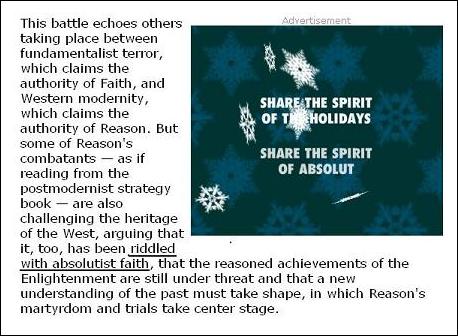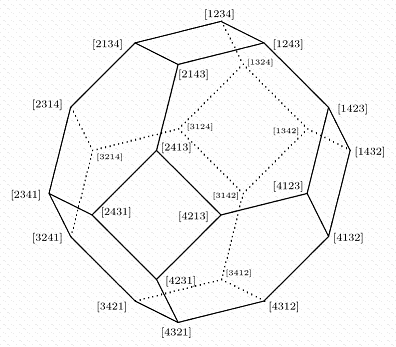From a search for Absolut Riddle in this journal —
Friday, May 10, 2019
Walpurgisnacht Riddle
Thursday, January 23, 2014
Riddled
From this journal on Dec. 20, 2003 ("White, Geometric, and Eternal") —
Riddled:
The Absolutist Faith
of The New York Times

See also Dead Poets' Word and A Riddle for Davos, as well as…
Monday, December 22, 2008
Monday December 22, 2008
Part I:
Ratio
Continued from…
|
White and Geometric,
but not Eternal. |
Part II:
Fides
For more information,
click on the cocktail.
Saturday, December 17, 2005
Saturday December 17, 2005
the Absolute
— Emily Dickinson
From John Spencer's birthday,
December 20, in 2003:
Riddled:
The Absolutist Faith
of The New York Times

White and Geometric, but not Eternal.
(See previous entry.)
The title of this entry
comes from within
an entry of June 2, 2005,
Saturday, December 20, 2003
Saturday December 20, 2003
White, Geometric, and Eternal
This afternoon's surfing:
Prompted by Edward Rothstein's own Fides et Ratio encyclical in today's NY Times, I googled him.
At the New York Review of Books, I came across the following by Rothstein:
"… statements about TNT can be represented within TNT: the formal system can, in a precise way, 'talk' about itself."
This naturally prompted me to check what is on TNT on this, the feast day of St. Emil Artin. At 5 PM this afternoon, we have Al Pacino in "The Devil's Advocate" — a perfect choice for the festival of an alleged saint.
Preparing for Al, I meditated on the mystical significance of the number 373, as explained in Zen and Language Games: the page number 373 in Robert Stone's theological classic A Flag for Sunrise conveys the metaphysical significance of the phrase "diamonds are forever" — "the eternal in the temporal," according to Stone's Catholic priest. This suggests a check of another theological classic, Pynchon's Gravity's Rainbow. Page 373 there begins with the following description of prewar Berlin:
"white and geometric."
This suggests the following illustration of a white and geometric object related to yesterday's entry on Helmut Wielandt:

Figure 1
(This object, which illustrates the phrase "makin' the changes," also occurs in this morning's entry on the death of a jazz musician.)
A further search for books containing "white" and "geometric" at Amazon.com yields the following:

Figure 2
From Mosaics, by
Fassett, Bahouth, and Patterson:
"A risco fountain in Mexico city, begun circa 1740 and made up of Mexican pottery and Chinese porcelain, including Ming.
The delicate oriental patterns on so many different-sized plates and saucers [are] underlined by the bold blue and white geometric tiles at the base."
Note that the tiles are those of Diamond Theory; the geometric object in figure 1 above illustrates a group that plays a central role in that theory.
Finally, the word "risco" (from Casa del Risco) associated with figure 2 above leads us to a rather significant theological site associated with the holy city of Santiago de Compostela:

Figure 3
Vicente Risco's
Dedalus in Compostela.
Figure 3 shows James Joyce (alias Dedalus), whose daughter Lucia inspired the recent entry Jazz on St. Lucia's Day — which in turn is related, by last night's 2:45 entry and by Figure 1, to the mathematics of group theory so well expounded by the putative saint Emil Artin.
"His lectures are best described as
polished diamonds."
— Fine Hall in its Golden Age,
by Gian-Carlo Rota
If Pynchon plays the role of devil's advocate suggested by his creation, in Gravity's Rainbow, of the character Emil Bummer, we may hope that Rota, no longer in time but now in eternity, can be persuaded to play the important role of saint's advocate for his Emil.
Update of 6:30 PM 12/20/03:
Riddled:
The Absolutist Faith
of The New York Times

White and Geometric, but not Eternal.



